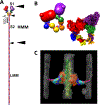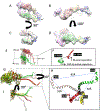Double-headed binding of myosin II to F-actin shows the effect of strain on head structure
- PMID: 37414375
- PMCID: PMC10544818
- DOI: 10.1016/j.jsb.2023.107995
Double-headed binding of myosin II to F-actin shows the effect of strain on head structure
Abstract
Force production in muscle is achieved through the interaction of myosin and actin. Strong binding states in active muscle are associated with Mg·ADP bound to the active site; release of Mg·ADP allows rebinding of ATP and dissociation from actin. Thus, Mg·ADP binding is positioned for adaptation as a force sensor. Mechanical loads on the lever arm can affect the ability of myosin to release Mg·ADP but exactly how this is done is poorly defined. Here we use F-actin decorated with double-headed smooth muscle myosin fragments in the presence of Mg·ADP to visualize the effect of internally supplied tension on the paired lever arms using cryoEM. The interaction of the paired heads with two adjacent actin subunits is predicted to place one lever arm under positive and the other under negative strain. The converter domain is believed to be the most flexible domain within myosin head. Our results, instead, point to the segment of heavy chain between the essential and regulatory light chains as the location of the largest structural change. Moreover, our results suggest no large changes in the myosin coiled coil tail as the locus of strain relief when both heads bind F-actin. The method would be adaptable to double-headed members of the myosin family. We anticipate that the study of actin-myosin interaction using double-headed fragments enables visualization of domains that are typically noisy in decoration with single-headed fragments.
Keywords: Filaments; Helical reconstruction; Lipid monolayer; Single particle reconstruction; Structural adjustments to strain; Structure heterogeneity.
Copyright © 2023 Elsevier Inc. All rights reserved.
Conflict of interest statement
Declaration of Competing Interest The authors declare that they have no known competing financial interests or personal relationships that could have appeared to influence the work reported in this paper.
Figures




Similar articles
-
Definite differences between in vitro actin-myosin sliding and muscle contraction as revealed using antibodies to myosin head.PLoS One. 2014 Jun 11;9(2):e93272. doi: 10.1371/journal.pone.0093272. eCollection 2014. PLoS One. 2014. PMID: 24918754 Free PMC article.
-
Structural characterization of the binding of Myosin*ADP*Pi to actin in permeabilized rabbit psoas muscle.Biophys J. 2006 Nov 1;91(9):3370-82. doi: 10.1529/biophysj.106.086918. Epub 2006 Aug 11. Biophys J. 2006. PMID: 16905611 Free PMC article.
-
Chemical decoupling of ATPase activation and force production from the contractile cycle in myosin by steric hindrance of lever-arm movement.Biophys J. 2003 Feb;84(2 Pt 1):1047-56. doi: 10.1016/S0006-3495(03)74921-2. Biophys J. 2003. PMID: 12547786 Free PMC article.
-
Changes in actin and myosin structural dynamics due to their weak and strong interactions.Results Probl Cell Differ. 2002;36:7-19. doi: 10.1007/978-3-540-46558-4_2. Results Probl Cell Differ. 2002. PMID: 11892285 Free PMC article. Review.
-
Visualizing myosin's power stroke in muscle contraction.J Cell Sci. 2000 Oct;113 ( Pt 20):3551-62. doi: 10.1242/jcs.113.20.3551. J Cell Sci. 2000. PMID: 11017871 Review.
References
Publication types
MeSH terms
Substances
Grants and funding
LinkOut - more resources
Full Text Sources

